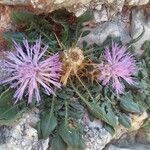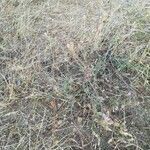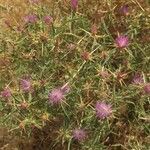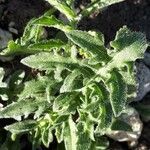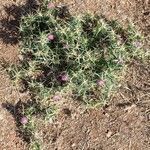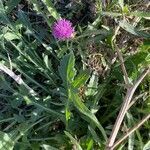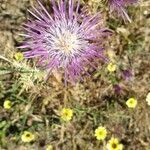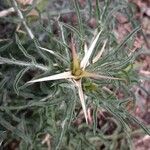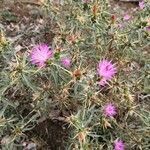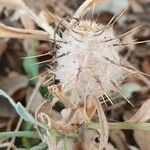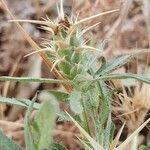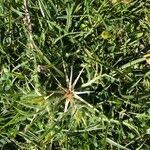Annual or biennial to 1 m high. Stems with adpressed arachnoid hairs, becoming glabrous; wings absent. Cauline leaves ovate to lanceolate, pinnatifid (lower) to entire (upper), green to grey-green above and below, with sparse scabrid and multicellular hairs; sessile glands present. Capitula solitary, pedunculate; involucre ovoid, 6–8 mm diam. at anthesis; median involucral bracts elliptic to ovate, 5–7 mm long, 3–5.5 mm wide, glabrous; appendages comprising a straight, patent, pungent, terminal spine 8–24 mm long with 1–3 pairs of spinules at base. Florets pink to mauve; inner (fertile) florets with tube 10.5–14 mm long, glandular, and lobes 2.5–4.5 mm long; sterile florets c. same length as fertile florets. Anthers 5–7.5 mm long. Achenes ellipsoid, 3–3.7 mm long, glabrous, streaked brown and grey. Pappus absent or present, with longest bristles c. 1.5 mm long.
Biennial. Stems erect, weakly ribbed, branched, (15)-30-60 cm tall, with sparse to dense multicellular hairs. Lvs not decurrent on stems, with sparse to dense multicellular hairs; lower lvs deeply pinnatifid, 5-10 × 1.5-4 cm, with oblong to lanceolate or linear, toothed or lobed segments; upper lvs becoming smaller, sometimes simple. Capitula shortly stalked, not clustered. Involucre ovoid to cylindric, 5-8 mm diam.; outer and middle bracts elliptic to oblong, not veined, glabrous; appendages spreading, not covering bracts, spinous, slightly narrowed at junction with bract, not decurrent on bract; terminal spine 15-20 mm long, yellowish; lateral spines 2-3 on each side, 2-3 mm long, all at base of terminal spine. Florets pink to purple, the outer slightly radiate. Corolla with glandular papillae. Achenes c. 3 mm long, glabrous; pappus 0.
Annual or biennial herb, up to 600 mm high. Stems thin, wiry, not winged, glabrous. Leaves alternate; blade elliptic or obovate in outline, deeply pinnatifid almost to midrib, segments linear to narrowly elliptic, margins denticulate, lightly pubescent; basal leaves petiolate, stem leaves sessile. Heads discoid, 15-20 mm long, solitary. Involucral bracts glabrous, in a few rows, imbricate, bracts tipped with rigid, yellow spines, 15-25 mm long, often with shorter spines at base of central spine. Flowers: disc florets only, bright purple; Apr. Fruit with cypsela oblong. Pappus absent.
An annual plant although it sometimes takes 2 years to complete its life cycle. It forms a bush and is slightly woolly. It grows about 1 m high. The leaves at the base form a ring and are deeply divided into narrow lobes. The stem is pale coloured. It is branched, and hairy when young. It becomes smooth with age. The stem leaves are much divided and they get smaller towards the top of the plant. The flowers are pinkish-purple. They are surrounded by bracts with yellow spines at the ends. These spines can be 2.5 cm long. The plant can send out runners in sandy soil.
Branching biennial 1–8 dm, arachnoid-villous or glabrate; lvs small, pinnatifid with narrow lobes, or the upper entire; heads numerous, narrow; invol 10–18 mm, its bracts weakly spinose-ciliate and stoutly spine-tipped, the larger spines 1–3 cm; fls few, purple; pappus none; 2n=18. Native of Europe, now widespread in the U.S. as a roadside weed. June–Sept.
Annual herb, 0.2-0.4 m high; freely and divaricately branched; stems thin. Leaves elliptic in outline, deeply pinnatifid almost to midrib, segments linear-lanceolate, margins toothed-incised. Involucral bracts 10-12, oval, coriaceous, glabrous with spreading, stout spines. Florets neuter, inner bisexual; purplish. Flowering time Nov.-Feb.
